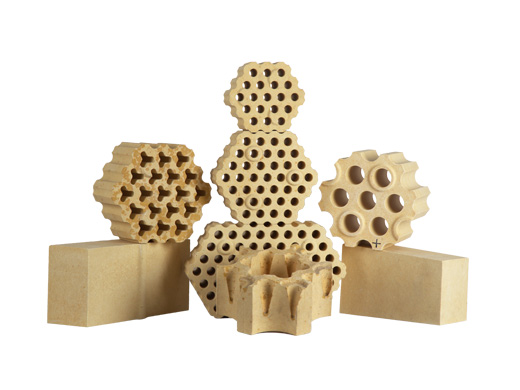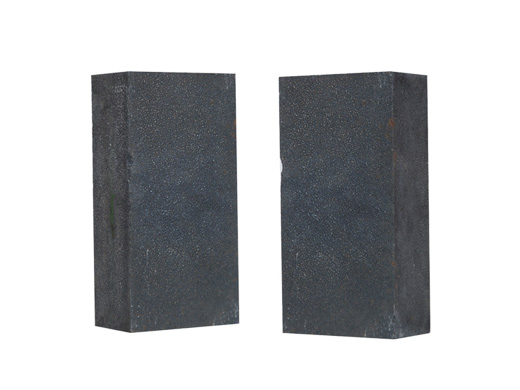Refractory materials in various parts of the furnace and precautions for use
Industry news | Refractory Wiki | Refractory news | Enterprise news |In the glass industry, the quality of refractory materials is of great significance for improving the quality of glass products, saving fuel, extending furnace life and reducing glass production costs. Refractory material is the material basis of glass kiln, which has a great impact on the overall efficiency of the kiln, and must be selected reasonably. The working state of each part of the kiln is different. The properties of the required refractories are also different.
1. tank wall bricks
The ideal wall brick material for the tank kiln that melts soda-lime-silicon material and contains stretched material is fused lead corundum brick. The inclined pouring brick with Zr02 content of 33%, the gate is outward, and placed below. Due to the heavy acid erosion when melting alkali-free or low-alkali glass fibers, the material of the tank wall bricks should be AZS bricks or dense zircon bricks, or fused silica bricks.
2. tank floor bricks
tank floor bricks are required to be wear-resistant and integral. Now more multi-layer composite tank bottom structure is used. The multi-layer structure is generally a thermal insulation layer built under the main layer 1—the large clay bricks. A protective layer and a wear-resistant layer are provided on the top of the large clay brick. The protective layer is made of zircon sand ramming material or fused corundum ramming material. The wear-resistant layer is on the protective layer to protect the bottom of the ramming tank and directly contact with the glass liquid. The fused AZS bricks with good corrosion resistance and wear resistance are commonly used. The effect of this composite tank bottom structure is: reduce heat dissipation loss , extending the life of the bottom of the tank. In order to prevent material leakage when melting glass containing heavy metal elements (such as lead glass) or glass with heavier erosion (such as opal glass), a protective layer and a wear-resistant layer can be added on top of the original protective layer and wear-resistant layer. Grinding layer. The original protective layer and wear-resistant layer are also called secondary paving layers, which can be sintered AZS bricks or zircon bricks.
3. Feeding tank bricks
The bricks of the feeding tank are affected by the erosion of the powder and the glass liquid, the wear of the material layer, the erosion of the liquid flow and the influence of the flame, so the damage is more serious. High-temperature wear-resistant and erosion-resistant materials are required, and fused lead corundum bricks containing Zr0241% without shrinkage cavities are commonly used, and the brick thickness is increased and air cooling is strengthened. In addition to corner bricks, other parts can use ordinary poured AZS-33 bricks. The lower charging tank bricks can also be considered to be poured kaolin large bricks.
4. dog house hole brick
The flow rate of the glass liquid in the dog house hole in the kiln is the largest, and the convection is obvious, so the wear is serious and the corrosion loss is accelerated. Therefore, AZS-41 bricks without shrinkage holes should be used for the cover bricks of the liquid flow hole, and the same material as the cover bricks should be used for the side wall bricks of the liquid flow holes, at least the bricks without shrinkage holes should be used. Fused silica bricks are used when melting silicate glass.
5. Bricks for cooling tank and forming tank
The molten and clarified glass liquid is already in the cooling and forming tank, and it has entered the later stage of the melting process. At this time, absolutely can not cause any defects (including bubbles, streaks, stones) to the glass liquid. The cooling tank needs to use AZS-33 bricks produced by oxidation method, and its glass phase precipitation temperature is high, and it will not bring bubbles to the glass liquid. The forming tank (such as the feed channel) should be made of fused aβAL203 bricks or fused a-AL2O3 bricks.
6. Bricks for kiln crown and breast wall
The damage characteristics of this part of the brick body are erosion (mainly alkaline sulfate agglomeration, forming honeycomb erosion) and burning. It is required to use a material that is extremely stable to alkali vapor at high temperature, and has a high softening temperature under load and creep resistance. Silica bricks, high-quality silica bricks and fused AZS-33 bricks can be selected.
7. Bricks for front wall and lattice wall
These are the front and rear walls of the melting room. They also have both erosion and burn damage characteristics. In addition, the front face wall is one of the weak points of the tank kiln, which is eroded by the wear and corrosion of the batch materials and the overflowing flame. At present, fused AZS-33 bricks are used, and high-quality silica bricks and sintered AZS bricks are also used in combination (such as L-shaped hanging walls). In addition to using high-quality silica bricks, the front wall also needs to be air-cooled.
8. Small furnace bricks
Small furnace bricks can be divided into craters, small furnace necks, nozzle bricks and other parts to be considered. Bricks for small furnaces require high temperature resistance, erosion resistance, erosion resistance, and certain thermal vibration resistance. Silica bricks or even kaolin clay bricks can be used when burning furnace gas (small heat load). If burning high calorific value When fuel is used (large heat load), the crater smashing bricks, the crater side wall bricks, the floor bricks, the slanted interlayer bricks, the tongue bricks and the nozzle bricks use electrofusion AZS-33 bricks, and the baseplate can also use sintered dense corundum bricks.
9. Selection of refractory materials for special parts
There are some special parts on the kiln masonry, such as bubbling holes. Kiln sill, electrode hole, inspection hole, measuring hole, etc. They have specialized uses as well as their own damage characteristics. The parts of the glass tank kiln that are not in contact with the glass liquid, such as the kiln crown of the upper structure, the kiln wall, the crater, the charging system, etc., are damaged by high temperature, dust erosion and chemical erosion of various volabricks. Volabricks are used to drain the molten glass, batches and combustion products. The main components are alkali metal oxides, tungsten compounds, and chlorides, chlorinated and sulfur compounds. These volabricks exist in the state of alkali vapor at high temperature, and condense into liquid phase when the temperature is low. See Table 10-37 for the refractory materials used in the upper part of the kiln and the heat exchange device.
Newest
- 2023-07-31
Properties of silicon nitride and its application in refract···...
- 2023-07-31
Properties of silicon nitride and its application in refract···...
- 2023-07-31
Properties of silicon nitride and its application in refract···...
- 2023-07-31
Properties of silicon nitride and its application in refract···...
- 2023-07-31
To explore the application of magnesia carbon brick in refra···...
Solution
- 2022-11-22
The technical requirements and production processes of fused···...
- 2022-09-06
Price Determinants of high alumina fire bricks...
- 2022-08-30
Technical performance and technology of silica mullite brick···...
- 2022-08-27
Refractory materials in various parts of the furnace and pre···...
- 2022-08-23
Magnesite chrome brick composition process classification...




